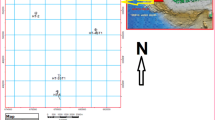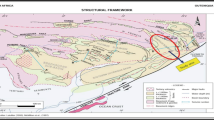Abstract
The study was carried out with the aim of predicting uncertainty using Sequential Indicator Simulation (SISIM) for lithofacies modelling, sequential Gaussian simulation (SGSIM) for reservoir property modelling and inferring the depositional environment using Flow Zone Indicator (FZI). Five well logs, core analysis data and 3D seismic data were used for the study. Reservoir sand named “Reservoir-E” was correlated across the five wells in the field, and its surface was mapped on the seismic sections from the 3D cube. Petrophysical evaluations revealed average, net to gross, porosity, permeability, the volume of shale, water saturation, hydrocarbon saturation (SH), Reservoir Quality Index (RQI) and FZI as 0.70, 0.29, 2342 mD, 0.158, 0.50, 0.50, 2.44 and 5.62 μm, respectively. Structural interpretations on seismic sections revealed five major faults which trend NE-SW, NW-SE and W-E. A 3D grid with dimension 204 × 120 × 5 = 122,400 was constructed to accommodate our model. Validation of lithofacies models shows a correlation coefficient of 89.43–92.98% for well data and model. The property model shows variability in effective porosity and permeability 0.24 to 0.38 and 560 to 5600 mD. The low amount of SH in well HT-2 and HT-3ST1 is attributed to the presence of baffles with low reservoir quality index with 1.81 and 1.67 for RQI and 5.05 and 5.27 for FZI as compared to well HT-1, HT-4ST1 and HT-5 with RQI of 3.61, 2.71 and 2.41 and FZI of 6.25, 5.85 and 5.66. The environment of deposition is interpreted to be mouth bar-upper shoreface. High porosity and permeability values are linked with high FZI and RQI which are targets for exploitation.




















Similar content being viewed by others
References
Abdel-Fattah M, Metwalli F, Mesilhi E (2018) Static reservoir modelling of the Bahariya reservoirs for the oilfields development in South Umbarka area, Western Desert Egypt. J Afr Earth Sci 138:1–13
Abdelmaksoud A, Ewida HF, El-Habaak GH, Amin AT (2019a) 3D structural modelling of the upper Bahariya member in Abu Gharadig oil and gas field, North Western Desert. Egypt. J Afr Earth Sci 150(C):685–700
Abdelmaksoud A, Amin AT, El-Habaak GH, Ewida HF (2019b) Facies and petrophysical modelling of the upper Bahariya member in Abu Gharadig oil and gas field, North Western Desert, Egypt. J Afr Earth Sci 149(C):503–516
Ajaegwu NE, Odoh BI, Akpunonu EO, Obiadi II, Anakwuba EK (2012) Late Miocene to Early Pliocene palynostratigraphy and palaeoenvironments of ANE-1 Well, Eastern Niger Delta, Nigeria. J Min Geol 48(1):31–43
Ali M, Abdelhady A, Abdelmaksound A, Darwish M, Essa MA (2019a) 3D static modelling and petrographic aspects of the Albian/Cenomanian reservoir, Komombo Basin, Upper Egypt. Nat Resour Res 29:1259–1281. https://doi.org/10.1007/s11053-019-09521-5
Ali M, Abdelmaksound A, Essa MA, Abdelhady A, Darwish M (2019b) 3D structural, facies and petrophysical modeling of C member of Six Hills Formation, Komombo Basin, Upper Egypt. Nat Resour Res. https://doi.org/10.1007/s11053-019-09583-5
Allen JRL (1965) Late quaternary Niger Delta and adjacent areas: sedimentary environments and lithofacies. Bull Am Pet Geol 49:547–600
Amaefule JO, Altunbay M, Tiab D, Kersey DG, Keelan DK (1993) Enhanced reservoir description: using core and log data to identify hydraulic flow units and predict permeability in uncored intervals/Wells. 68th annual technical conference of the Society of Petroleum Engineers, Houston, Texas. October 3-6, p. 205–220
Armstrong M (1984) ‘Using geostatistics to predict the characteristics of Washed Coal’, J Min Eng., p. 369–373
Asquith G, Krygowski D (2004) Basic well log analysis: AAPG methods in exploration, 16, 31–35
Avbovbo AA (1978) Tertiary lithostratigraphy of Niger Delta: American Association of Petroleum Geologists Bulletin, 62, 295–300
Bacon M, Simm R, Redshaw T (2003) 3-D seismic interpretation. Cambridge University Press, New York
Barakat MK, El-Gendy NH, El-Bastawesy MA (2019) Structural modeling of the Alam El-Bueib Formation in the jade oil field, Western Desert, Egypt. J Afr Earth Sci 156:168–177
Chukwu GA (1991) The Niger Delta complex basin: stratigraphy, structure and hydrocarbon potential. J Pet Geol 14:211–220. https://doi.org/10.1111/j.1747-5457.1991.tb00363.x
De Souza EG, Scherer CMS, dos Reis AD, Bállico MB, Ferronatto JPF, Bofill LM, Kifumbi C (2019) Sequence stratigraphy of the mixed wave-tidal-dominated mesoproterozoic sedimentary succession in Chapada Diamantina Basin, Espinhaço Supergroup–Ne/Brazil. Precambrian Res 327:103–120. https://doi.org/10.1016/j.precamres.2019.03.007
Deutsch CV, Journel AG (1998) Geostatistical software library (GSLIB).Oxford University Press, Oxford, 2nd edition, 369 p
Doust H, Omatsola E (1989) Niger delta. American Association of Petroleum Geologist Bulletin, 48, 201–238
Geboy NJ, Olea RA, Engle MA, Martín-Fernández JA (2013) Using simulated maps to interpret the geochemistry, formation and quality of the blue gem coal bed, Kentucky, USA. Int J Coal Geol 112:26–35
Goovaerts P (1997) Geostatistics for natural resources evaluation. Oxford University Press, New York, p 483
Jika HT, Onuoha KM, Dim CIP (2019) Application of geostatistics in facies modelling of reservoir-E “Hatch Field” offshore Niger Delta Basin, Nigeria. J Pet Explor Prod Technol 10:769–781. https://doi.org/10.1007/s13202-019-00788-1
Journel A (1982) The indicator approach to estimation of spatial distributions. 17th APCOM Symposium Prooceedings. Society of Mining Engineers, p.793-806
Journel AG, Huijbregts CJ (1978) Mining geostatistics. Academic Press, London, p 600
Koneshloo M, Saman AA, Hu X (2018) The impact of geological uncertainty on primary production from a fluvial reservoir. Pet Sci 15:270–288
Kulke H (1995) Nigeria, regional petroleum geology of the world. Part II: Africa, America, Australia and Antarctica. Berlin, Gebrüder Borntraeger, 8, 143–172
Li X, Zhang J, Liu L, Fan Z, Zhang G, Li C (2016) Three-dimensional reservoir architecture modelling by geostatistical techniques in BD block, Jinhu depression, northern Jiangsu Basin, China. Arab J Geosci 9:654. https://doi.org/10.1007/s12517-016-2694-1
Liang B, Khan S, Tang Y (2017) Fracture hit monitoring and its mitigation through integrated 3D Modelling in the Wolfcamp stacked pay in the Midland Basin. In Unconventional Resources Technology Conference, Austin, Texas, 24-26 July 2017 (pp. 1763-1778). DOI https://doi.org/10.15530/urtec-2017-2671336
Ma Y, Zhu X, Guo T, Rebec T, Azbel K (2005) Reservoir characterization using seismic data after frequency bandwidth enhancement. J Geophys Eng 2(3):213–221. https://doi.org/10.1088/17422132/2/3/005
Maleki Tehrani MA, Asghari O, Emery X (2012) Simulation of mineral grades and classification of mineral resources by using hard and soft conditioning data: application to Sungun porphyry copper deposit. Arab J Geosci 6:3773–3781
Malvic T (2009) Geostatistics as a group of methods for advanced mapping of geological variables in hydrocarbon reservoirs. Annu Croat Acad Eng 12:69–83
Olea RA (1994) Fundamentals of semivariogram estimation, modeling, and usage. In: Yarus J.M. and chambers, R.L. (eds), Stochastic modeling and geostatistics: principles, methods, and case studies. AAPG Computer Application in Geology, 3, 27–35
Owoyemi AOD (2004) The sequence stratigraphy of Niger Delta field, offshore Nigeria. Msc thesis, Texas A&M University
Oyeyemi KD, Olowokere MT, Aizebeokhai AP (2018) Prospect analysis and hydrocarbon reservoir volume estimation in an exploration field, shallow offshore depobelt, Western Niger Delta, Nigeria. Nat Resour Res 28:173–185
Oyeyemi KD, Olowokere MT, Aizebeokhai AP (2019) Prospect analysis and hydrocarbon reservoir volume estimation in an exploration field, shallow offshore depobelt, Western Niger Delta, Nigeria. Nat Resour Res 28(1):173–185
Qadri SMT, Islam MA, Shalaby MR, Eahsanul-Haque AK (2017) Seismic interpretation and structural modelling of Kupe field, Taranaki Basin, New Zealand. Arab J Geosci 10:295
Remy N, Boucher A, Wu JB (2009) ‘Applied geostatistics with SGeMS, ‘Cambridge University Press: Cambridge, UK, 264 p
Short KC, Stauble AJ (1967) Outline of geology of Niger Delta. Am Assoc Pet Geol Bull 51:761–779
Stacher P (1995) Present understanding of the Niger Delta hydrocarbon habitat, in, Oti, M.N., and Postma, G., eds., Geology of Deltas: Rotterdam, A.A. Balkema, p. 257–267
Stieber SJ (1970) Pulsed neutron capture log evaluation - Louisiana Gulf Coast. Fall Meeting of the Society of Petroleum Engineers of AIME October 4-7, p. 1–7. https://doi.org/10.2118/2961-MS.
Tukey JW (1977) Exploratory data analysis. Addison-Wesley Publ. Co., Menlo Park, p 688
Uguru CI, Onyeagoro UO, Lin J, Okkerman J, Sikiru IO (2005) Permeability prediction using genetic unit averages of flow zone indicators (FZIs) and neural networks. 29th Annual International Conference and Exhibition of the Society of Petroleum Engineers, Abuja, Nigeria. August 1-3, p.1–8. https://doi.org/10.2118/98828-MS.
Yilmaz O (1987) Seismic data processing: Society of Exploration Geophysics. V2, 526p
Acknowledgments
Special thanks and appreciation are due to the management of Dharmattan Nigeria Ltd. for making available the work station used for this research work.
Funding
Financial assistance was received from Petroleum Technology Development Funds and also the Department of Petroleum Resources (DPR) Nigeria and made available the data used in this research.
Author information
Authors and Affiliations
Corresponding author
Additional information
Responsible Editor: Santanu Banerjee
Rights and permissions
About this article
Cite this article
Jika, H.T., Onuoha, M.K., Okeugo, C.G. et al. Application of sequential indicator simulation, sequential Gaussian simulation and flow zone indicator in reservoir-E modelling; Hatch Field Niger Delta Basin, Nigeria. Arab J Geosci 13, 410 (2020). https://doi.org/10.1007/s12517-020-05332-8
Received:
Accepted:
Published:
DOI: https://doi.org/10.1007/s12517-020-05332-8




